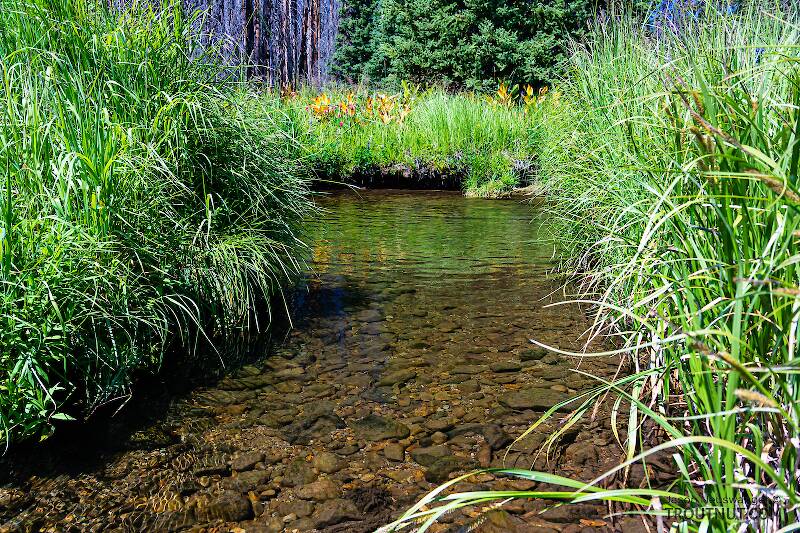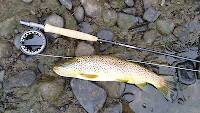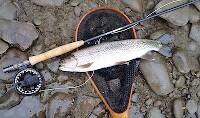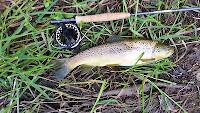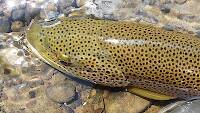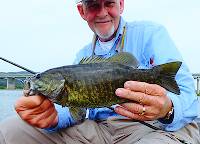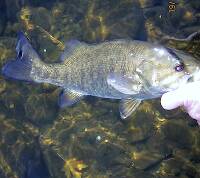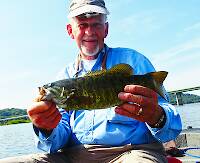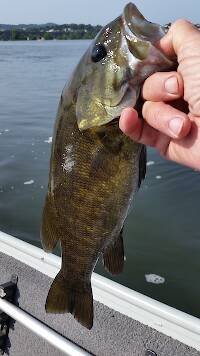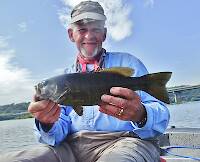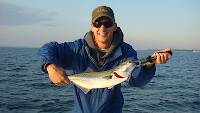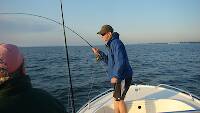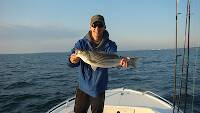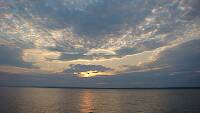
Blue-winged Olives
Baetis
Tiny Baetis mayflies are perhaps the most commonly encountered and imitated by anglers on all American trout streams due to their great abundance, widespread distribution, and trout-friendly emergence habits.
Featured on the forum

This species was fairly abundant in a February sample of the upper Yakima.

Troutnut is a project started in 2003 by salmonid ecologist Jason "Troutnut" Neuswanger to help anglers and
fly tyers unabashedly embrace the entomological side of the sport. Learn more about Troutnut or
support the project for an enhanced experience here.
Davez on Jul 23, 2007July 23rd, 2007, 5:29 am EDT
I've read a number of posts here with guys that have a hard time landing big fish. I decided to throw a post together of what i do when a big fish is on. I'm not the expert, I still break off big fish once in a while, but I do have a good success rate.
the do's...
1. sharp hooks
2. check tippet/leader often. size it right. (no double bunnies on 6x!)
3. side pressure, side pressure, side pressure when fighting.
4. change angles alot. pull that fish from every direction.
5. if you need it, use a net. i don't always use a net. only when in the drift boat, or when wading the big rivers.
6. i don't rely on drags. i own lots of $$$$$ reels, and they all will eventually slip or get stuck. even if you take care of them. argue this if you like, but ive managed to wear out an Able, and break a Loop. they were reels with thousands of miles on them, so its noit their fault.
7. be aware of the fishes environment- where is he going to go when you set the hook! (logjam!)
8. get a good hookset.
9. get practice. thats a tough one. you have to learn by first hooking a big fish! I grew up in NW Pa, and have fished steelhead and cohos on flies since the 80s. Then it was tarpon fishing in the keys 10 years ago- a 12wt rod, 9 foot leader, and 16lb tippet can be used to effectively land a 96 pound tarpon.
10. lube your knots. and tie good ones. theres a whole confusing discussion on this on the forum...
the dont's.....
1. don't give him slack.
2. tis better to break off than to fight him to exhaustion. don't kill em.
3. avoid putting pressure on the rod blank above the grip. I watched a steelhead fisherman in NYS explode a rod by doing this broke right across his finger!
4. dont use cheap hooks that will bend out.
one im not sure about is: get the fish on the reel. I've landed lots of big fish both ways. i guess it depends on the situation. I don;t always get them on the reel.
thats all i got, please add more..
the do's...
1. sharp hooks
2. check tippet/leader often. size it right. (no double bunnies on 6x!)
3. side pressure, side pressure, side pressure when fighting.
4. change angles alot. pull that fish from every direction.
5. if you need it, use a net. i don't always use a net. only when in the drift boat, or when wading the big rivers.
6. i don't rely on drags. i own lots of $$$$$ reels, and they all will eventually slip or get stuck. even if you take care of them. argue this if you like, but ive managed to wear out an Able, and break a Loop. they were reels with thousands of miles on them, so its noit their fault.
7. be aware of the fishes environment- where is he going to go when you set the hook! (logjam!)
8. get a good hookset.
9. get practice. thats a tough one. you have to learn by first hooking a big fish! I grew up in NW Pa, and have fished steelhead and cohos on flies since the 80s. Then it was tarpon fishing in the keys 10 years ago- a 12wt rod, 9 foot leader, and 16lb tippet can be used to effectively land a 96 pound tarpon.
10. lube your knots. and tie good ones. theres a whole confusing discussion on this on the forum...
the dont's.....
1. don't give him slack.
2. tis better to break off than to fight him to exhaustion. don't kill em.
3. avoid putting pressure on the rod blank above the grip. I watched a steelhead fisherman in NYS explode a rod by doing this broke right across his finger!
4. dont use cheap hooks that will bend out.
one im not sure about is: get the fish on the reel. I've landed lots of big fish both ways. i guess it depends on the situation. I don;t always get them on the reel.
thats all i got, please add more..
GONZO on Jul 23, 2007July 23rd, 2007, 6:04 am EDT
Good stuff, Dave. And you're right that getting practice can often be the tough part. Fishing where big fish are the norm rather than the exception certainly helps build competence and confidence. I liked your "i don't rely on drags" comment, though others might argue the point. To me, the main function of a drag is to keep the reel from "overspinning" when a big fish runs. Any additional pressure can often be applied more effectively by manual means. But then, I'm an old school click-and-pawl kind of guy.
PS--"From Hook-up to Hand" (general section) has a few (?) thoughts on the subject.
PS--"From Hook-up to Hand" (general section) has a few (?) thoughts on the subject.
CaseyP on Jul 23, 2007July 23rd, 2007, 6:09 am EDT
Dave, your hints are right on. this last trip i made sure to be always exerting pressure from the side which made a huge difference in my rate of landings. and though i always carry a net, more and more only big fish go in it.
now a question to all and sundry: i remove the hook before i take pictures because i got tired of dropping the fish and making both of us go through the whole landing thing again. better i drop a free fish. however, if i am alone on the water, how can i take anything other than a "peek into the MeasureNet" shot? is there a way to hold a fish with one hand that's not injurious to it or me? discovered one day the hard way that trouts got teeth.
now a question to all and sundry: i remove the hook before i take pictures because i got tired of dropping the fish and making both of us go through the whole landing thing again. better i drop a free fish. however, if i am alone on the water, how can i take anything other than a "peek into the MeasureNet" shot? is there a way to hold a fish with one hand that's not injurious to it or me? discovered one day the hard way that trouts got teeth.
"You can observe a lot by watching." Yogi Berra
Chris_3g
Posts: 59
Posts: 59
Chris_3g on Jul 23, 2007July 23rd, 2007, 6:15 am EDT
I've only landed three fish that I would consider large enough to fall into this category (and they're pushing it), but I have a couple of suggestions. They might be obvious to most, but they were things I never thought of until I actually landed my first big fish!
First, if you do use a net, put the net in the water early. I've found that if I get a fish close enough to think about netting without the net in the water, I send the fish into a frenzy when I first dip the net in the water - hence starting another short fight that could lose the fish.
Also, as a general rule, I try to limit how far downstream the fish heads. It's a lot harder to pull a fish from downstream than from upstream. Most of the time, you don't have a choice, but that's my $0.02.
Chris.
First, if you do use a net, put the net in the water early. I've found that if I get a fish close enough to think about netting without the net in the water, I send the fish into a frenzy when I first dip the net in the water - hence starting another short fight that could lose the fish.
Also, as a general rule, I try to limit how far downstream the fish heads. It's a lot harder to pull a fish from downstream than from upstream. Most of the time, you don't have a choice, but that's my $0.02.
Chris.
GONZO on Jul 23, 2007July 23rd, 2007, 7:17 am EDT
Chris--both good points.
Casey, sounds like you got the old bloody-thumb-from-holding-trout-like-bass thing! Sometimes a trout will relax when cradled gently under the belly, sometimes not. Regardless, the picture that results is often lousy. (I know whereof I speak; I've taken lots of lousy fish pictures.) Here's what I'd recommend:
Whenever you realize that you've hooked a fish you must capture photographically (and that you might actually land), start looking for a shallow spot near shore where it's possible for the fish to be on its side but still partially submerged (an inch or so of water). After netting the fish and removing the hook (in the water), lay the fish in the net in that spot. (You can lay your rod alongside--mostly just to get it out of the way, but it also adds perspective). Work quickly to snap a shot or two, then hold the fish upright in flowing water until it swims away. If any complications arise that might cause unacceptable delays, abandon the effort and release the fish. Flopping that might injure the fish can usually be prevented by covering the fish's eye while you ready the shot.
A few provisos:
1. If you can't see such a spot, if the fight has been unusually long, or ESPECIALLY IF THE WATER IS WARM, abandon the photo idea, revive the fish carefully, and live with the memory. (When the water is very warm, you probably shouldn't be fishing for trout anyway.)
2. If your first or second shot is lousy, you can carefully turn the fish over so the other set of gills is in the water and snap another. (But don't get carried away; discretion is the better part of fish photography.)
3. Some consider it egotistical to want to get pictures of fish (and it is, I suppose), but I would also point everyone to David's (DMM's) excellent post in the "Catch and Release" thread (in the general section). I have great faith in what he says there, and it matches my experience.
is there a way to hold a fish with one hand that's not injurious to it or me?
Casey, sounds like you got the old bloody-thumb-from-holding-trout-like-bass thing! Sometimes a trout will relax when cradled gently under the belly, sometimes not. Regardless, the picture that results is often lousy. (I know whereof I speak; I've taken lots of lousy fish pictures.) Here's what I'd recommend:
Whenever you realize that you've hooked a fish you must capture photographically (and that you might actually land), start looking for a shallow spot near shore where it's possible for the fish to be on its side but still partially submerged (an inch or so of water). After netting the fish and removing the hook (in the water), lay the fish in the net in that spot. (You can lay your rod alongside--mostly just to get it out of the way, but it also adds perspective). Work quickly to snap a shot or two, then hold the fish upright in flowing water until it swims away. If any complications arise that might cause unacceptable delays, abandon the effort and release the fish. Flopping that might injure the fish can usually be prevented by covering the fish's eye while you ready the shot.
A few provisos:
1. If you can't see such a spot, if the fight has been unusually long, or ESPECIALLY IF THE WATER IS WARM, abandon the photo idea, revive the fish carefully, and live with the memory. (When the water is very warm, you probably shouldn't be fishing for trout anyway.)
2. If your first or second shot is lousy, you can carefully turn the fish over so the other set of gills is in the water and snap another. (But don't get carried away; discretion is the better part of fish photography.)
3. Some consider it egotistical to want to get pictures of fish (and it is, I suppose), but I would also point everyone to David's (DMM's) excellent post in the "Catch and Release" thread (in the general section). I have great faith in what he says there, and it matches my experience.
CaseyP on Jul 23, 2007July 23rd, 2007, 8:47 am EDT
all hail the newly-discovered search box on this site! the comments by DMM (David) under "Catch and Release" are really helpful, and while i remember reading them, i forgot what he said. thankyou!
"You can observe a lot by watching." Yogi Berra
GONZO on Jul 23, 2007July 23rd, 2007, 9:01 am EDT
Hey, Casey, are you home yet? I just saw more coverage of the flooding in England--looks really bad. You were lucky to get any fishing at all, let alone catch those British beauties.
CaseyP on Jul 23, 2007July 23rd, 2007, 5:12 pm EDT
oh, yes, safely home, just. that cloudburst that flooded the south of the country killed the London Underground line by line as i tried to get to Paddington Station to get to the airport. made it at last by bus in bright sunshine (weird!) and of course needn't have worried: the flights were all delayed too.
as Jason says: be the trout. in this case, underwater and trying not to get caught!
and BTW, before you go to the Great Beyond, fish the River Wharf. really. it's all as beautiful as a calendar and after you find them the fish gobble up size 16 bhpt nymphs when you get tired of trying more sophisticated approaches. that's why i wished i'd known how to photograph larger fish when solo...
as Jason says: be the trout. in this case, underwater and trying not to get caught!
and BTW, before you go to the Great Beyond, fish the River Wharf. really. it's all as beautiful as a calendar and after you find them the fish gobble up size 16 bhpt nymphs when you get tired of trying more sophisticated approaches. that's why i wished i'd known how to photograph larger fish when solo...
"You can observe a lot by watching." Yogi Berra
GONZO on Jul 24, 2007July 24th, 2007, 12:23 pm EDT
Welcome home, Casey. Good to have you back. (And I'm glad you didn't have to swim!)
Wiflyfisher on Jul 24, 2007July 24th, 2007, 3:31 pm EDT
Just a suggestion about how I have been doing photos lately. I happen to attend several conventions each year and they give attendees and speakers a cloth-type long band that wraps around your neck and hangs down in front of you holding your name badge. I use this to attach a small camera and it hangs down just inside the top of my waders. Now I can quickly pull out (without fear of dropping it) and I can do a one-handed point and click shot of a fish, wildlife or a buddy falling in, etc...
The only thing is you need a waterproof point-and-click camera or be willing to risk a small point-and-click camera if you take a tumble. I don't fall in much lately so I use the latter.
Very often I don't get a shot of the fish, even with the camera stuffed in my waders because I want to get the trout back in the water and released. Besides the memories I remember long after I loose track of where I put the folder with all those digital photos.
The only thing is you need a waterproof point-and-click camera or be willing to risk a small point-and-click camera if you take a tumble. I don't fall in much lately so I use the latter.
Very often I don't get a shot of the fish, even with the camera stuffed in my waders because I want to get the trout back in the water and released. Besides the memories I remember long after I loose track of where I put the folder with all those digital photos.
John S.
https://WiFlyFisher.com
https://WiFlyFisher.com
Quick Reply
Related Discussions
Topic
Replies
Last Reply
1
Nov 18, 2007
by Martinlf
by Martinlf
2
Jan 23, 2017
by Mcflyangler
by Mcflyangler

